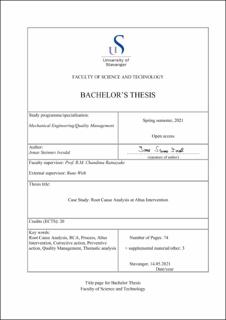| dc.contributor.advisor | Ratnayake Mudiyanselage, Chandima | |
| dc.contributor.advisor | With, Rune | |
| dc.contributor.author | Steinnes Ivesdal, Jonas | |
| dc.date.accessioned | 2021-09-07T16:27:09Z | |
| dc.date.available | 2021-09-07T16:27:09Z | |
| dc.date.issued | 2021 | |
| dc.identifier | no.uis:inspera:78876263:6697527 | |
| dc.identifier.uri | https://hdl.handle.net/11250/2774294 | |
| dc.description.abstract | This thesis carries out a case study of Altus Interventions Root Cause Analysis, focusing on the reporting program Synergi and the methodology surrounding it. The central thesis objective is to map the current methodology and suggest improvements. The following research questions were formulated to limit the scope:
RQ1: What is Altus Interventions current Root Cause Analysis methodology?
RQ2: What efforts can be made to improve Altus Interventions current Root Cause Analysis methodology
With semi-structured interviews followed by thematic analysis, a qualitative approach was utilised to capture Altus Interventions' current standing in relation to a set of guidelines and criteria on root cause analysis. The thematic analysis resulted in a set of themes representing concrete improvement areas.
The main findings were that Synergi is a functioning program to perform root cause analysis, but a list of challenges is hindering full utilisation of the program. The first main area of improvement is to align Synergi to the company vision and strategy by creating a bottom-up engagement for Synergi use, which requires management to convey results from Synergi to the organisation. Further, by updating and making procedures more visible, ownership and engagement might increase.
The second area deals with improving the competence in Synergi reporting and processing, which can be done by highlighting the importance of plausibility and reproducibility and clearly stating a company-wide definition of root cause and its practical implication.
Third, with updated and visible documentation, different roles can be expected to carry out their responsibility, which today is somewhat unclear.
Finally, it is advised to double down on Synergi for root cause analysis and improve the program for this use. Recommendations to improve the program is improving data input and identify the possibilities for program development. | |
| dc.description.abstract | This thesis carries out a case study of Altus Interventions Root Cause Analysis, focusing on the reporting program Synergi and the methodology surrounding it. The central thesis objective is to map the current methodology and suggest improvements. The following research questions were formulated to limit the scope:
RQ1: What is Altus Interventions current Root Cause Analysis methodology?
RQ2: What efforts can be made to improve Altus Interventions current Root Cause Analysis methodology
With semi-structured interviews followed by thematic analysis, a qualitative approach was utilised to capture Altus Interventions' current standing in relation to a set of guidelines and criteria on root cause analysis. The thematic analysis resulted in a set of themes representing concrete improvement areas.
The main findings were that Synergi is a functioning program to perform root cause analysis, but a list of challenges is hindering full utilisation of the program. The first main area of improvement is to align Synergi to the company vision and strategy by creating a bottom-up engagement for Synergi use, which requires management to convey results from Synergi to the organisation. Further, by updating and making procedures more visible, ownership and engagement might increase.
The second area deals with improving the competence in Synergi reporting and processing, which can be done by highlighting the importance of plausibility and reproducibility and clearly stating a company-wide definition of root cause and its practical implication.
Third, with updated and visible documentation, different roles can be expected to carry out their responsibility, which today is somewhat unclear.
Finally, it is advised to double down on Synergi for root cause analysis and improve the program for this use. Recommendations to improve the program is improving data input and identify the possibilities for program development. | |
| dc.language | eng | |
| dc.publisher | uis | |
| dc.title | Case Study: Root Cause Analysis at Altus Intervention | |
| dc.type | Bachelor thesis | |
